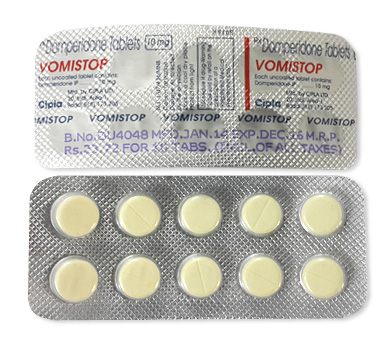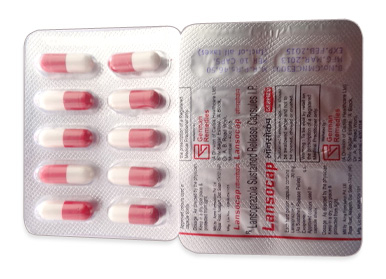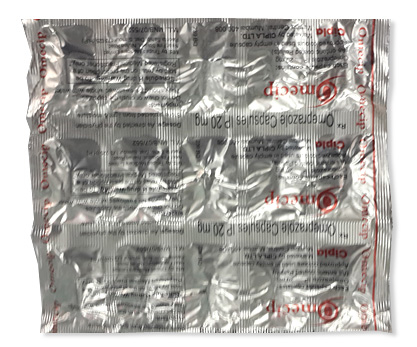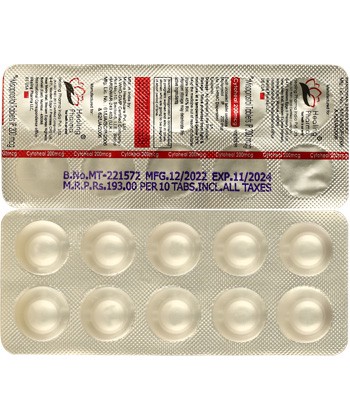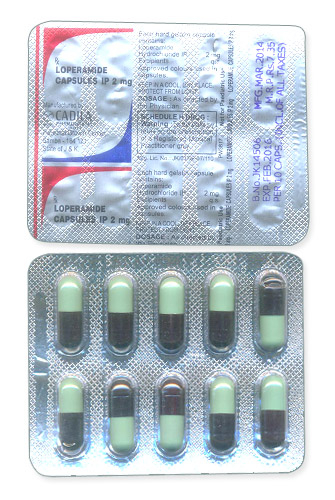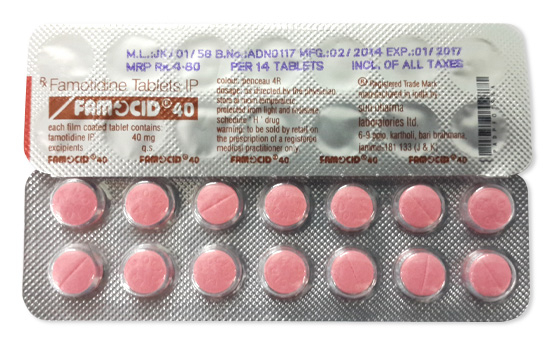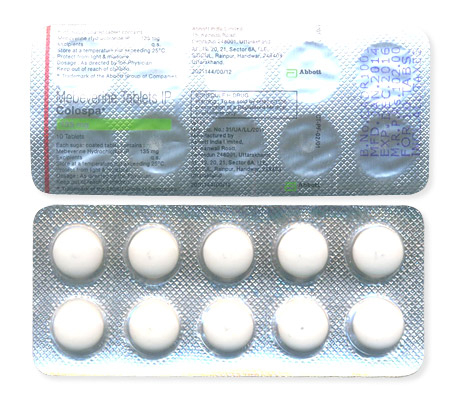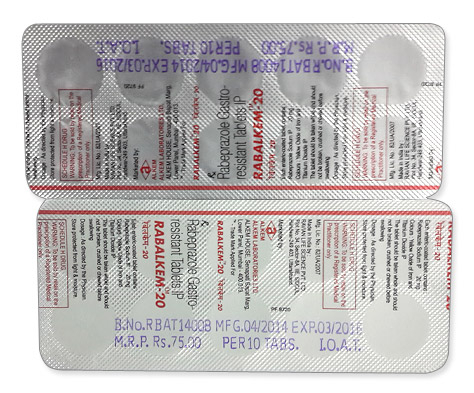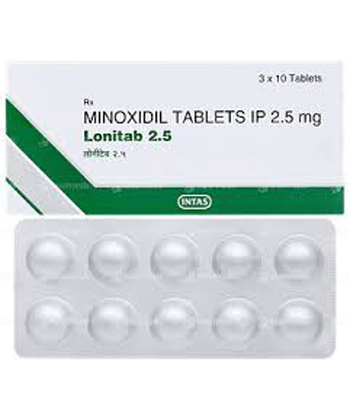Rabeprazole
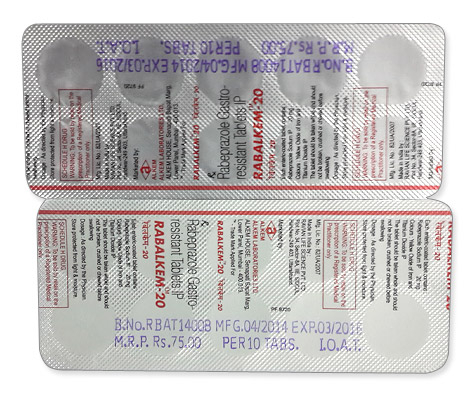
Rabeprazole
- Rabeprazole requires a prescription and can be purchased at pharmacies globally under brand names like AcipHex (US), Pariet (EU/UK/Japan), Rabicip (India), and generics. Delivery timelines vary by region.
- Rabeprazole treats gastro-oesophageal reflux (GERD), duodenal ulcers, Zollinger-Ellison Syndrome, and H. pylori infections (in combination therapy). It works by inhibiting gastric proton pumps, reducing stomach acid production through irreversible binding to H⁺/K⁺ ATPase enzymes.
- Usual dosages include 20 mg once daily for GERD and duodenal ulcers, 20 mg twice daily for H. pylori eradication (with antibiotics), and 60 mg daily (titrated) for Zollinger-Ellison Syndrome. Adjustments may be needed for severe hepatic impairment.
- Administered orally as enteric-coated tablets (10 mg, 20 mg) to bypass stomach acid degradation. Granules/suspensions exist for pediatric use in limited markets.
- Onset occurs within 1 hour with rapid proton pump inhibition, though symptomatic relief for acid-related conditions typically develops over 1–4 days after starting treatment.
- The duration of acid suppression lasts approximately 24 hours per dose, supporting once-daily regimens for most conditions (except H. pylori therapy).
- Avoid or limit alcohol consumption, as it may increase stomach acidity and exacerbate conditions like GERD, counteracting rabeprazole’s therapeutic effects.
- Most common side effects include headache, diarrhea, abdominal pain, nausea, and flatulence. Less common are dizziness, rash, and back pain.
- Would you like to try Rabeprazole for effective acid reduction? Consult your doctor to discuss a prescription tailored to your needs.
Basic Rabeprazole Information
| INN | Rabeprazole |
| Brand Names (AU) | Pariet, Rabeprazole Sandoz, Rabemep |
| ATC Code | A02BC04 |
| Forms & Strengths | Enteric-coated tablets: 10mg, 20mg |
| Australian Manufacturers | Sandoz, Generic Health, Viatris |
| Registration Status | ARTG-listed (TGA-approved) |
| Classification | Prescription only (Rx) |
Rabeprazole is a prescription medication officially approved by Australia's Therapeutic Goods Administration. As a proton pump inhibitor, its ARTG listing confirms its safety and efficacy meet Australian regulatory standards. Local manufacturers typically supply this medication as enteric-coated tablets to prevent early breakdown in the digestive system. Unlike some over-the-counter antacids, rabeprazole requires medical supervision due to its potent acid-suppressing effects.
How Rabeprazole Works in Your Body
Rabeprazole operates as a proton pump inhibitor targeting stomach acid production at the cellular level. When swallowed, this prodrug travels inactive through your digestive tract until reaching the acidic environment of gastric parietal cells. There, it transforms into its active form that irreversibly blocks hydrogen-potassium ATPase enzymes - the microscopic acid pumps lining your stomach walls.
By inhibiting these proton pumps, rabeprazole drastically reduces basal and stimulated acid secretion. Its effect typically begins within one hour with peak activity around 2-4 hours post-dose. Unlike some older PPIs, rabeprazole does not extensively rely on liver enzymes (CYP450 system) for metabolism, resulting in fewer medication interactions. Most inactive metabolites exit the body through urine after non-enzymatic conversion.
Approved Conditions and Medical Uses
The TGA authorizes rabeprazole for specific gastric conditions based on clinical evidence:
- Gastro-oesophageal reflux disease (GORD) healing and symptom control
- Duodenal and gastric ulcer treatment
- Helicobacter pylori eradication combined with antibiotics
- Zollinger-Ellison syndrome management
Some practitioners prescribe it off-label for NSAID-induced ulcer prevention or functional dyspepsia management. However, prescription regulations require proper diagnosis through procedures like endoscopy or breath testing before initiation. Self-medication is inappropriate due to potential masking of serious gastrointestinal conditions.
Administration Guidelines and Standard Dosing
| Medical Condition | Standard Adult Dosage | Duration |
|---|---|---|
| GORD/Symptomatic Reflux | 20mg once daily | 4-8 weeks |
| Peptic Ulcers | 20mg once daily | 4-6 weeks |
| H. pylori Eradication | 20mg twice daily (with antibiotics) | 7-14 days |
Swallow tablets whole before breakfast without crushing or chewing. Food significantly decreases absorption, making morning administration crucial. If you miss a dose, take it when remembered unless nearing the next scheduled dose. Maintain storage below 25°C in original packaging to prevent moisture damage. In suspected overdose situations, seek immediate medical attention - symptomatic treatment remains primary management.
Dosage Modifications for Specific Patients
Older Adults: Seniors may require closer monitoring due to increased medication sensitivity and comorbid conditions affecting metabolism.
Paediatric Use: Limited application in Australian children; requires specialist consultation due to insufficient safety data for those under 12.
Liver Impairment: Reduced doses potentially needed in severe hepatic dysfunction with careful monitoring for adverse effects.
Kidney Problems: No routine adjustment for renal impairment, though caution remains advised in end-stage disease.
Pregnancy Considerations: Category B1 classification - potential benefits must outweigh risks with healthcare professional guidance required.
Breastfeeding: Trace amounts appear in breast milk; consider alternatives during lactation.
Rabeprazole Safety Profile, Contraindications and Warnings
Rabeprazole is generally well-tolerated but requires careful consideration of safety factors. Hypersensitivity reactions to rabeprazole or other proton pump inhibitors represent absolute contraindications. Rash, breathing difficulties, or swelling after taking any PPI require immediate discontinuation. Several precautions apply for specific patient groups:
- Severe liver impairment: Dose reduction may be necessary as metabolism occurs primarily in the liver
- Osteoporosis risk: Long-term therapy correlates with increased fracture risk, particularly with high doses exceeding one year
- Gut infections: Elevated Clostridioides difficile infection risk due to reduced stomach acidity
- Nutrient deficiencies: Possible hypomagnesemia and vitamin B12 malabsorption with extended use
- Kidney concerns: May occur in rare cases of acute interstitial nephritis
Common adverse reactions affect 1-10% of users and typically include headache, nausea, diarrhoea, and abdominal discomfort. These mild effects often resolve without intervention. Serious reactions (<1%) require immediate medical attention:
- Severe cutaneous reactions (Stevens-Johnson syndrome, toxic epidermal necrolysis)
- Hepatitis or jaundice indicating liver dysfunction
- Signs of hypersensitivity (facial swelling, breathing difficulty)
TGA labelling mandates warnings about reduced magnesium levels with prolonged treatment and potential interactions with medications affected by pH changes (e.g. HIV medications, certain antifungals). Regular monitoring of magnesium, liver function, and bone density is recommended during extended therapy.
Rabeprazole Patient Experience and Reported Outcomes
Australian users commonly report faster heartburn relief with rabeprazole compared to some other PPIs, with many experiencing symptom improvement within the first two days. Patients managing peptic ulcers typically note significant pain reduction within one week. Rabeprazole's tolerability often receives positive feedback, particularly from those who switched due to side effects from omeprazole or pantoprazole.
Long-term users highlight challenges including the need to time doses precisely before meals and concerns about potential bone density impacts. Discontinuation difficulties occur frequently, with rebound acid hypersecretion causing temporary worsening of symptoms if stopped abruptly. Many patients require gradual dose reduction under medical supervision.
Pharmacists emphasise the importance of consistency - taking doses at the same time daily works best. Patients sometimes mistake this medication for immediate symptom relief rather than preventative treatment, leading to premature discontinuation when symptoms don't immediately resolve. Individual variability remains significant - what works effectively for one person's acid reflux may prove inadequate for another. Consistent adherence to the prescribed schedule significantly impacts real-world effectiveness for chronic conditions like GERD.
Rabeprazole Alternatives Comparison and Therapeutic Positioning
Australia's main PPI alternatives include several equally effective options with varying pharmacokinetics and costs. This comparison table helps contextualise rabeprazole's position:
| Medication | Onset Time | Cost (PBS General) | Interaction Profile | Common Doses |
|---|---|---|---|---|
| Rabeprazole | 1-2 hours | $15.50 (20mg) | Lower CYP450 impact | 10-40mg daily |
| Omeprazole | 1-3 days | $8.10 (20mg) | Multiple interactions | 20-40mg daily |
| Pantoprazole | 2-4 days | $9.20 (40mg) | Few interactions | 20-40mg daily |
| Esomeprazole | 1-2 hours | $13.20 (20mg) | Moderate interactions | 20-40mg daily |
Rabeprazole offers faster onset than most alternatives and the most favourable drug interaction profile - particularly valuable for elderly patients taking multiple medications. Australian prescribers often select it for rapid relief in severe GERD cases or when concurrent medications exclude other PPIs. While pantoprazole remains a common first choice due to lower cost and fewer interactions, rabeprazole exhibits comparable effectiveness at slightly higher PBS pricing. Therapeutic positioning considers symptom severity rather than significant clinical superiority among PPIs.
Rabeprazole Market Availability and Cost in Australia
This proton pump inhibitor is widely available across Australian pharmacies. All major chains like Chemist Warehouse, Amcal, and Priceline routinely stock rabeprazole. The PBS lists it for specific gastrointestinal conditions including:
- Gastro-oesophageal reflux disease
- Peptic ulcer disease
- Pathological hypersecretory conditions
- H. pylori eradication therapy
Generic proton pump inhibitor forms dominate the market, with brand names including Ausrab, Pariet, Ribic and Rabemep. Concession card holders pay $7.70 per script while general patients pay between $15.50-$19.70 depending on packaging. PBS safety net thresholds apply after approximately 14 filled prescriptions annually. Without subsidy, prices range from $30-$45 for 30 tablets.
Standard packaging contains either bottles of 30 tablets or calendar blister packs. Prolonged use requires new prescriptions every six months under PBS regulations. Demand remains consistent year-round without significant seasonal variation. All community pharmacies throughout NSW, Victoria, Queensland and other states maintain regular stock, though specific brands vary by location. Online pharmacies require valid Australian prescriptions for dispensing.
Current Research, Trends & Future Outlook
Australian researchers have intensified studies on rabeprazole's effectiveness across diverse populations, particularly examining genomic factors affecting treatment response. A recent Monash University trial demonstrated superior acid control in GERD patients aged over 65 compared to older PPIs. Investigational applications show promise in Barrett's oesophagus management, though chemoprevention claims require further validation through TGA-monitored studies.
Reanalysis of long-term safety data confirms magnesium deficiency risks after 3+ years of continuous use, prompting updated Australian prescribing guidelines recommending intermittent dosing where clinically appropriate. All patents protecting rabeprazole expired domestically before 2015, resulting in numerous affordable generic alternatives listed on the PBS. Pharmacists note intensified scrutiny of GI medication regimens following 2023 guideline updates emphasising:
- Shortest effective duration for uncomplicated GERD
- Calcium/vitamin D co-supplementation in osteoporosis risk patients
- H. pylori testing before initiating long-term therapy
Evidence-Based FAQs
These answers address common Australian patient concerns:
Can stopping rabeprazole abruptly cause problems? Tapering over 2-4 weeks prevents rebound acid hypersecretion, especially after long-term use. Discuss reduction strategies with your GP.
Is tablet splitting effective? Never split enteric-coated rabeprazole tablets - this compromises acid protection and risks oesophageal irritation. Use prescribed strengths only.
How does alcohol interact? While no direct pharmacological interaction exists, alcohol exacerbates gastric irritation. Limit intake during treatment periods.
What about pregnancy use? Classified B1 - potential benefits may warrant use during pregnancy under specialist supervision after reviewing risks.
Can I safely drive? Generally safe, though rare cases of dizziness occur. Monitor initial reactions before operating heavy machinery.
Where to purchase safely? Only through Australian-registered pharmacies requiring valid prescriptions to avoid counterfeit risks.
Managing long-term therapy? Annual GP reviews including bone density/B12/magnesium checks; explore symptom-triggered dosing.
Guidelines for Proper Use & Handling
Optimise therapy effectiveness through these evidence-backed practices:
Administration protocol: Swallow whole tablet with water 30-60 minutes before breakfast. Avoid antacids within 2 hours of dosing as they interfere with absorption.
Dietary considerations: Limit trigger foods (caffeine/spicy/fatty meals) during GERD treatment. Inform your pharmacist about complementary herbals - St John's Wort may reduce efficacy.
Storage requirements: Maintain below 25°C in original packaging protecting from humidity. Discard if tablets appear discoloured.
Avoid these errors: Skipping doses consistently compromises healing; extending duration without review increases adverse event risks; crushing tablets destroys enteric coating.
Critical actions: Thoroughly review the CMI leaflet; clarify instructions with community pharmacists; immediately report breathing difficulties/rash/swelling; maintain symptom diaries; attend scheduled GP monitoring appointments.

